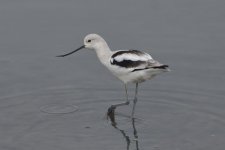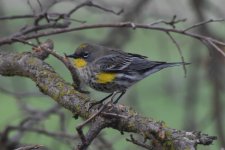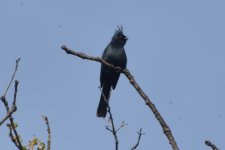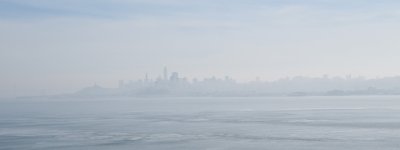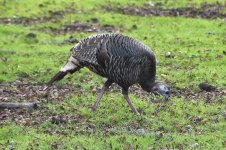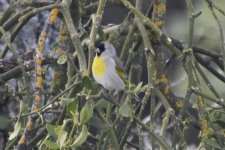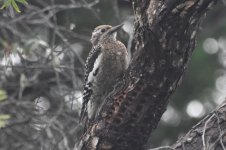25 January 2024
Today it was up the coast in southern San Mateo County and northern Santa Cruz County on California Highway 1, the highway that runs along most of the California coast. I stopped first at the Whale City Bakery in Davenport for a breakfast pastry. I have had many fine pastries here previously, but the bear-claw today had been left in the oven just a bit too long; it was dry and the almond slivers over-toasted. It was a good large size, but at $7, I expected better. Pescadero State Beach was where I began birding. My main target here was Wandering Tattaler. The tide was high and the surf was high and I really did not have a lot of hope that I would locate it. Despite what you might think from the name, in winter they are actually very quiet birds. They are usually solitary, so you can’t locate a mixed flock and then have a good chance of locating the bird within it. Sometimes you do get lucky, however. At my first stop I parked facing the ocean and a rock that had a few gulls roosting on it. I got out the spotting scope. There were also Whimbrels, Black Oystercatchers, Black Turnstones, Surfbirds, and lower down, away from all the other birds, a Wandering Tattler. The ebird list may be found here: https://ebird.org/checklist/S159856670.
Sometimes you do not get lucky. Next on my agenda was a Red-naped Sapsucker that has been up Stage Road, a couple miles north of the town of Pescadero. I knew the site from years past (an Eastern Phoebe wintered here for several years), but today I could not find any sapsuckers, or even any fresh-looking sapsucker workings. After about an hour I left, went back to Highway 1, and headed south. A note for anyone who should find him- or herself in Pescadero at meal time: Duarte’s Tavern there is a very fine restaurant and well worth trying. Today I had brought my own lunch and passed it by. My ebird list for Stage Road is here: https://ebird.org/checklist/S159857308.
Heading back south, I saw some gulls on the beach at Gazos Creek State Beach and stopped for a quick look. Nothing unexpected will be found on this ebird list: https://ebird.org/checklist/S159857430.
Swanton Berry Farm has a small pond and welcomes visitors. They sell a few baked goods and sweets in a little shop; I recommend the blackberry truffle. The pond attracts some waterbirds, nearby shrubs and fields attract some sparrows and blackbirds, and the whole area can be good for raptors. Today the pond was nearly empty with just a few Mallards and Ruddy Ducks. Most winters there are dozens of Ring-necked Ducks and often others here. There was a flock of White-crowned Sparrows, but otherwise, sparrow-wise, only a single Song Sparrow. I had seen about a dozen Red-tailed Hawks driving up the coast this morning, so I was not surprised to see four here. There were a similar number of Northern Harriers, an American Kestrel, and a White-tailed Kite. I have been to several places this month where I expected to see kites, so I was happy to finally find one. Some bare trees held a few Purple Finches, another new species. The ebird list is here: https://ebird.org/checklist/S159857874.
Nearby is a little cove called Davenport Landing. It seems to get little coverage by local birders, though it has characteristics that would seem likely to bring in some rare birds: a tangle of willows and other trees along a small stream, right on the coast. Today it brought in windsurfers. I don’t know if the windsurfers were the cause, but there were not many birds on the ocean. The trees and shrubs did hold a few birds, including more Purple Finches and a Palm Warbler. My ebird list may be found at this address: https://ebird.org/checklist/S159858650.
I continued south to Santa Cruz, where I took care of a couple errands, had dinner, and went to a meeting of the Santa Cruz Bird Club. The dinner was a fish taco plate ($9) at Los Primos Taqueria. It was okay, but I think primo is more of a goal than a reality there. The meeting was a slide show by Norm Kikuchi on the Birds of Alaska. If you were looking for cutting-edge science or the minutia of bird identification, this was not the talk for you. Norm is a terrific photographer, however, and if you are looking for great photos of birds and fun anecdotes, then this was the place to be. I enjoyed it very much.
So there were three new species today, Wandering Tattler, White-tailed Kite, and Purple Finch, and the total is up to 200. It would seem I am half way to my goal of 400 birds for the year, and it is still January. It will get harder from here on, however. It will require some longer trips and some luck to get to 400.
Today it was up the coast in southern San Mateo County and northern Santa Cruz County on California Highway 1, the highway that runs along most of the California coast. I stopped first at the Whale City Bakery in Davenport for a breakfast pastry. I have had many fine pastries here previously, but the bear-claw today had been left in the oven just a bit too long; it was dry and the almond slivers over-toasted. It was a good large size, but at $7, I expected better. Pescadero State Beach was where I began birding. My main target here was Wandering Tattaler. The tide was high and the surf was high and I really did not have a lot of hope that I would locate it. Despite what you might think from the name, in winter they are actually very quiet birds. They are usually solitary, so you can’t locate a mixed flock and then have a good chance of locating the bird within it. Sometimes you do get lucky, however. At my first stop I parked facing the ocean and a rock that had a few gulls roosting on it. I got out the spotting scope. There were also Whimbrels, Black Oystercatchers, Black Turnstones, Surfbirds, and lower down, away from all the other birds, a Wandering Tattler. The ebird list may be found here: https://ebird.org/checklist/S159856670.
Sometimes you do not get lucky. Next on my agenda was a Red-naped Sapsucker that has been up Stage Road, a couple miles north of the town of Pescadero. I knew the site from years past (an Eastern Phoebe wintered here for several years), but today I could not find any sapsuckers, or even any fresh-looking sapsucker workings. After about an hour I left, went back to Highway 1, and headed south. A note for anyone who should find him- or herself in Pescadero at meal time: Duarte’s Tavern there is a very fine restaurant and well worth trying. Today I had brought my own lunch and passed it by. My ebird list for Stage Road is here: https://ebird.org/checklist/S159857308.
Heading back south, I saw some gulls on the beach at Gazos Creek State Beach and stopped for a quick look. Nothing unexpected will be found on this ebird list: https://ebird.org/checklist/S159857430.
Swanton Berry Farm has a small pond and welcomes visitors. They sell a few baked goods and sweets in a little shop; I recommend the blackberry truffle. The pond attracts some waterbirds, nearby shrubs and fields attract some sparrows and blackbirds, and the whole area can be good for raptors. Today the pond was nearly empty with just a few Mallards and Ruddy Ducks. Most winters there are dozens of Ring-necked Ducks and often others here. There was a flock of White-crowned Sparrows, but otherwise, sparrow-wise, only a single Song Sparrow. I had seen about a dozen Red-tailed Hawks driving up the coast this morning, so I was not surprised to see four here. There were a similar number of Northern Harriers, an American Kestrel, and a White-tailed Kite. I have been to several places this month where I expected to see kites, so I was happy to finally find one. Some bare trees held a few Purple Finches, another new species. The ebird list is here: https://ebird.org/checklist/S159857874.
Nearby is a little cove called Davenport Landing. It seems to get little coverage by local birders, though it has characteristics that would seem likely to bring in some rare birds: a tangle of willows and other trees along a small stream, right on the coast. Today it brought in windsurfers. I don’t know if the windsurfers were the cause, but there were not many birds on the ocean. The trees and shrubs did hold a few birds, including more Purple Finches and a Palm Warbler. My ebird list may be found at this address: https://ebird.org/checklist/S159858650.
I continued south to Santa Cruz, where I took care of a couple errands, had dinner, and went to a meeting of the Santa Cruz Bird Club. The dinner was a fish taco plate ($9) at Los Primos Taqueria. It was okay, but I think primo is more of a goal than a reality there. The meeting was a slide show by Norm Kikuchi on the Birds of Alaska. If you were looking for cutting-edge science or the minutia of bird identification, this was not the talk for you. Norm is a terrific photographer, however, and if you are looking for great photos of birds and fun anecdotes, then this was the place to be. I enjoyed it very much.
So there were three new species today, Wandering Tattler, White-tailed Kite, and Purple Finch, and the total is up to 200. It would seem I am half way to my goal of 400 birds for the year, and it is still January. It will get harder from here on, however. It will require some longer trips and some luck to get to 400.
Attachments
-
 Common Raven 2024-01-25 a.JPG1.2 MB · Views: 11
Common Raven 2024-01-25 a.JPG1.2 MB · Views: 11 -
 Golden-crowned Sparrow 2024-01-25 a.JPG368.4 KB · Views: 9
Golden-crowned Sparrow 2024-01-25 a.JPG368.4 KB · Views: 9 -
 Song Sparrow 2024-01-25 a.JPG252.4 KB · Views: 9
Song Sparrow 2024-01-25 a.JPG252.4 KB · Views: 9 -
 Purple Finch 2024-01-25 a.JPG144.5 KB · Views: 9
Purple Finch 2024-01-25 a.JPG144.5 KB · Views: 9 -
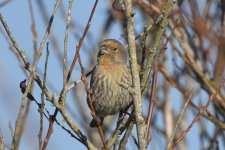 Female House Finches choose mates based on the amount of red in their plumage - maybe a challa...JPG404.3 KB · Views: 9
Female House Finches choose mates based on the amount of red in their plumage - maybe a challa...JPG404.3 KB · Views: 9 -
 Great Blue Heron 2024-01-25 a.JPG303.3 KB · Views: 10
Great Blue Heron 2024-01-25 a.JPG303.3 KB · Views: 10 -
 Shorebirds - how many can you find 2024-01-25 a.JPG2.3 MB · Views: 10
Shorebirds - how many can you find 2024-01-25 a.JPG2.3 MB · Views: 10






